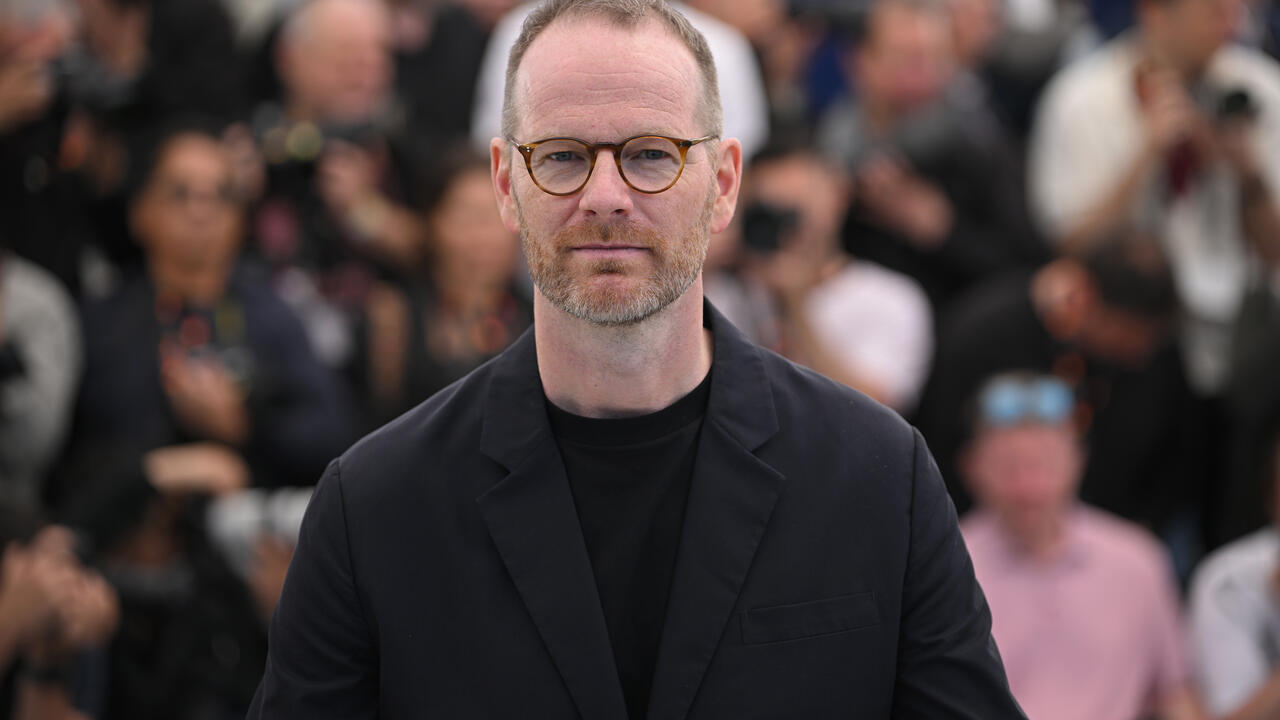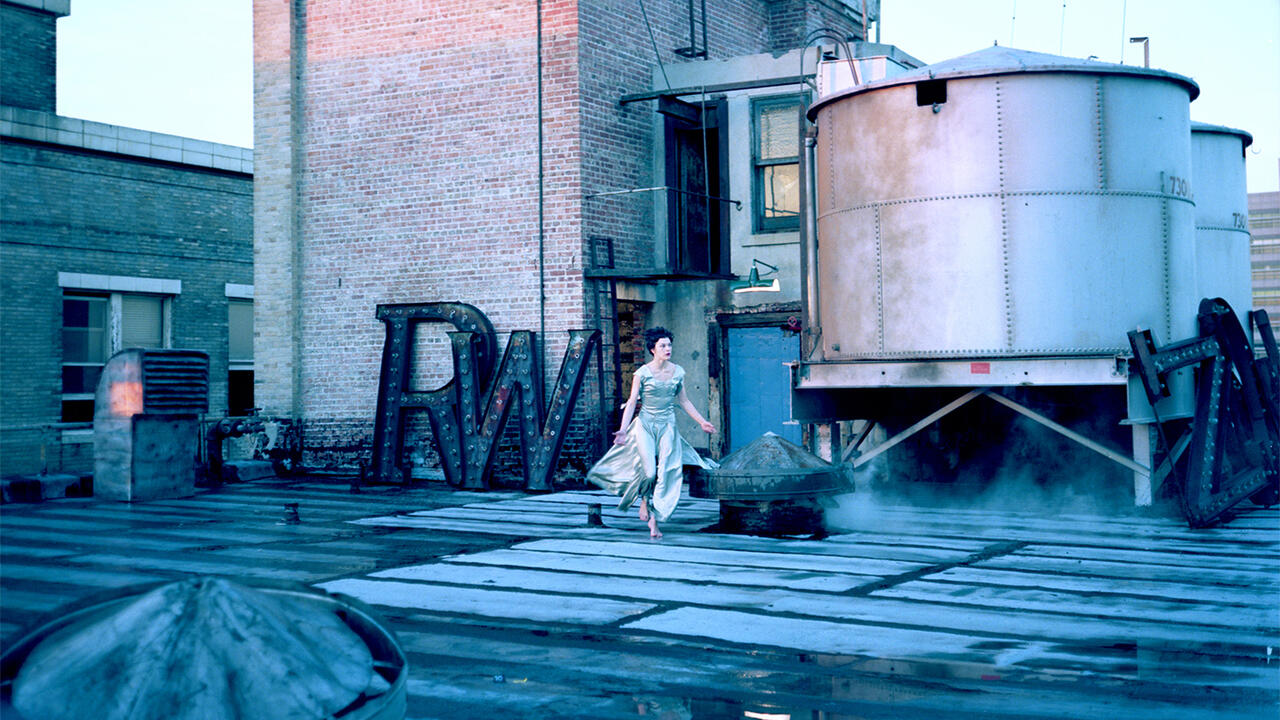Suspended Animation
Dealing with the lapses between narrative content and medium, Rosa Barba’s film and sculptural work is a meditation on memory and vision
Dealing with the lapses between narrative content and medium, Rosa Barba’s film and sculptural work is a meditation on memory and vision

‘Let me see it’ begins the deep, guttural voice-over in Rosa Barba’s short, enigmatic 16mm film of the same name (2009). An elliptical narrative tells the tale of an object – a dodecahedron – while an aerial shot circles over an obscure, twilit-red body of water dotted with small islands. Subtitles spell out the spoken words in a doubling-up of language that competes with the projected image, itself a substitute for the dodecahedron pictured in the mind’s eye. Vision and memory contend in this story about a strange object that the character cannot remember, and that the viewer never sees. The object becomes magnified in the imagination as the character’s attempts to picture it are matched by those of the viewer. It remains suspended, visible only in the hazy non-space of memory. This protracted state of suspension affects all aspects of the film: the aerial shot hovering over the land below; the story fragment with its abrupt start and lack of resolution (adapted from a short story by Jorge Luis Borges); the meaning that itself floats somewhere between spoken word and written text; and, of course, the image too, suspended in the projector’s steady beam of light.
Such a state of suspension is an active and recurring element in Barba’s film and sculptural work, suggesting a contingent, unresolved relation between narrative content and means of expression. In an ongoing series the 16mm projector, engaged in various kinds of contrapposto, becomes the central protagonist. In one work, Invisible Act (2011), a silver ball bearing balances on a moving strip of celluloid in front of the projector’s beam of light, to cast an image of its own balancing act on the wall ahead. In another, (Stating the Real Sublime, 2009), a projector hangs in mid-air, suspended by the celluloid itself, which feeds through a number of spools fixed to the ceiling; the small, white rectangle of projected light bounces and bobs as the projector sways on its tethers. The projector’s function is compromised: it becomes a dispossessed model of itself, dismembered and reordered to tautological or nonsensical effect. The usually invisible conveyors of meaning are thrust into the spotlight in Barba’s works, and fail spectacularly to be themselves; instead they become curiously self-conscious. This has an unsettling effect: the nuts and bolts of the films suddenly assume a clumsy solidity, at odds with the temporary magic of the transient image made of light.

Now based in Berlin, Barba was born in Sicily and raised in Germany, living an Italian home life within a German culture. She studied in Cologne in the 1990s and at Amsterdam’s Rijksakademie early last decade before beginning a peripatetic existence, moving from one artistic residency to another in various countries whose landscapes and cultural differences had a defining influence on the subject matter of her work. Outwardly from Earth’s Center (2007), for instance, was made on a small Swedish island during a residency at the Baltic Art Center in Visby, while the trilogy of films They Shine, Waiting Grounds and Western Round Table (all 2007), filmed in the Mojave Desert, followed a residency at the Villa Aurora in the Pacific Palisades, Los Angeles. ‘I see landscapes as documents where I place my stories,’Barba said in a recent interview.¹
The Long Road (2010) was also made in the Californian desert and relies on a similar kind of aerial shot as Let Me See It, this time on 35mm. This particular ‘document’ is of an abandoned racetrack in the desert whose looping shape is traced by the camera’s meandering movement from a helicopter overhead. A spare, esoteric soundtrack of distended, clashing cymbals, echoes and electronic twangs reinforces the alien appearance of this giant drawing inscribed on the desert: it looks otherworldly, like an enormous crop circle or a remnant of some long-forgotten ritual, slowly being absorbed by the land. Barba’s languid tracery and mute observation drown narrative in space while introducing time as a central theme; It is of the essence when it comes to racing, after all. But here there is no urgent need to beat the clock; time is instead ambiguous and uprooted. The past is never allowed to rest, and the future is never a given. It is the delicately balanced present we are faced with instead: the abandoned racetrack, as barren now as the blasted landscape around it. Fossilized evidence of an accidental earthwork, its complete form is visible only from the air.
In another archaeologically orientated film, A Private Tableaux (2010), Barba discovers ‘a century of markings’ on the ceiling of an underground tunnel. An introduction in slow-paced subtitles describes the discovery as ‘an automatic writing’ made by engineers examining the stability of the underground architecture, and thereby executing ‘a private tableaux’. Torch-lit in the dark tunnel, a shaking hand-held camera scans the ceiling to reveal white, loosely geometric markings, like paintings in an ancient cave. Squares, wavering lines and crosses are variously interpreted as ‘an eagle with outstretched wings’, ‘a flight machine’ or ‘the portrait of a young man’s face, reminiscent of Cocteau’s drawing [...] drawn directly from memory’. As the subtitles interrupt the images we see, not only do they direct a reading of these ‘pictures’, but they also layer the artist-as-narrator’s own interpretation over that of the engineer, the original author of the drawings, usurping his intentionality, or lack of it, with her own. She describes the Jean Cocteau portrait as having ‘given the engineer much trouble but little satisfaction’, though of course it is her own memory of this image, not the author’s, from which it is drawn. Barba is a classically (and consciously) unreliable narrator, whose own experience skews the interpretation of events, rushing in to fill in gaps of history or knowledge with her own fantastical imaginings.

Barba’s most recent long film, The Empirical Effect (2009), returns to Italy and to the landscape of Mount Vesuvius, and its surrounding villages, which are all, of course, inscribed with narrative and dense with historical event. This is a place that really does occupy the present, in a state of anxious suspension between past devastation and the precarious possibility of eruption at any time in the future. Barba’s film presents an intertwined portrait of the land and the inhabitants of the municipality of Ottaviano, which nestles on the shoulders of the volcano. Landscape and daily life are bound together irrevocably, a bond evidenced by the archival documents and scientific instruments that trace the history of the volcano’s activities, preserved in the Vesuvius Observatory, which is situated, oddly enough, right next to the crater, a fact that displays a surprising ambivalence towards the archive’s essential role of preservation.
The brooding atmosphere of the film, with its apocalyptic introductory voice-over, archival footage of populations living a century ago in the shadow of the sleeping mountain and aerial shots (again) of its current densely populated landscape, is undercut by the appearance of the cast, a gaggle of elderly residents, most of whom are old enough to have witnessed Vesuvius’s last major eruption in 1944. The slightly awkward self-consciousness of their actions in front of the camera introduces a note of uncertainty about the nature of the work: too staged to be a documentary, it is not a fully developed fiction either. It calls to attention the presence of the artist, directing the cast, rummaging through the archives, observing the instruments and editing the footage, which is held together by a sophisticated soundtrack by Barba’s frequent collaborator Jan St. Werner, and Andi Toma – his long time collaborator in the electronic music duo Mouse on Mars. The cast examine the various maps and materials at the Vesuvius Observatory, and tend to the giant model which covers its floor. The mountain is the film’s chief protagonist: a sleeping monster tended by minions awed and absorbed by its dormant presence. Towards the end of the film an evacuation is staged, and the town’s streets fill with young and old, fleeing their houses, clutching the hands of their children or a single possession, and jostling up the narrow alleyways. This is a gleeful, excited moment, the one they have been waiting for all this time: a chance to abandon the old order and take to the streets.
The archive was again called to the stage in an exhibition Barba curated at Madrid’s Museo Reina Sofía last year. Titled ‘A Curated Conference – On the Future of Collective Strength Within an Archive’, the show assembled a group of works from the museum’s collection, the earliest of which was made in 1917 (María Blanchard’s Mujer con guitarra, Woman with Guitar) and the most recent Paul Sietsema’s 2008 Figure 3. Barba approached the exhibition as a kind of conference of art works, a Babel of sometimes dissenting, sometimes agreeing voices. She called the pieces ‘participants’, and arranged them in sections denoted as ‘Round Table Discussions’ or ‘Workshops’, proposing an imagined animation of the art works that suggests the archive as something noisy and vivid rather than silently sitting accumulating dust. Barba argues for the everlasting present of a work of art that, despite its age, can articulate its position clearly in the here and now. This project in turn led to a new work titled The Hidden Conference (2010), a short, almost surreptitious torch-lit film which visits the storage vaults of a major museum. In a subtitled introduction, the film’s male narrator describes being witness to ‘a silent encounter [...] being conducted with a degree of urgency, despite having been in progress for years, even decades.’ Various sculptures, largely figurative works from many eras, are the film’s protagonists, arrayed on metal shelves or standing around in groups, their dramatic gestures, gaping mouths, galloping hooves suspended in a frozen but nonetheless urgent theatrical encounter. An unsuspecting cast captured as they engage in an ongoing silent ahistorical repartee.
What is the difference between an object and its memory, between a volcano now and a picture of its eruption 60 years ago, or between a sculpture freshly finished in an artist’s studio and another sitting for years in a museum vault? Barba’s preoccupation with these quandaries has an almost pantheistic effect on her work, as inanimate objects or landscapes are given leading roles or accorded central speaking parts. Where does memory reside and what does it look like? Let me see it.
1 Rosa Barba in an interview with Cecilia Alemani, KLAT #02, Spring 2010






















